AlgoC++第八课:手写BP
目录
- 手写BP
- 前言
- 1. 数据加载
- 2. 前向传播
- 3. 反向传播
- 总结
手写BP
前言
手写AI推出的全新面向AI算法的C++课程 Algo C++,链接。记录下个人学习笔记,仅供自己参考。
本次课程主要是手写 BP 代码
课程大纲可看下面的思维导图

1. 数据加载
我们首先来实现下MNIST数据集的加载工作
#include <iostream>
#include <tuple>
#include <string>
#include <fstream>
#include "matrix.hpp"using namespace std;namespace Application{namespace io{// 不要内存对齐struct __attribute__((packed)) mnist_labels_header_t{unsigned int magic_number;unsigned int number_of_items;}struct __attribute__((packed)) mnist_images_header_t{unsigned int magic_number;unsigned int number_of_images;unsigned int number_of_rows;unsigned int number_of_cols;}unsigned int inverse_byte(unsigned int v){unsigned char* p = (unsigned char*)&v;std::swap(p[0], p[3]);std::swap(p[1], p[2]);return v;}/* 加载mnist数据集 */tuple<Matrix, Matrix> load_data(const string& image_file, const string& label_file){// file, mode = rb/wb/a+Matrix images, labels;fstream fimage(image_file, ios::binary | ios::in);fstream flabel(label_file, ios::binary | ios::in)mnist_images_header_t images_header;mnist_labels_header_t labels_header;fimage.read((char *)&images_header, sizeof(images_header));flabel.read((char *)&labels_header, sizeof(labels_header));// 大小端转换images_header.number_of_images = inverse_byte(images_header.number_of_images);labels_header.number_of_items = inverse_byte(labels_header.number_of_items);images.resize(images_header.number_of_images, 28 * 28);// one hot, floatlabels.resize(labels_header.number_of_items, 10);// 中间存储作用, 它的大小等于文件中图像数据的大小std::vector<unsigned char> buffer(images.rows() * images.cols());fimage.read((char*)buffer.data(), buffer.size());// buffer 是unsigned char类型的图像数据,pixel// 现在需要转化到images矩阵中// 顺便把标准化给做了for(int i = 0; i < buffer.size() ++i)images.ptr()[i] = (buffer[i] / 255.0f - 0.1307f) / 0.3081f;// 开始处理label,ont-hot过程// labels是全零的矩阵buffer.resize(labels.rows());flabel.read((char*)buffer.data(), buffer.size());for(int i = 0; i < buffer.size(); ++i)labels.ptr(i)[buffer[i]] = 1; // one-hotreturn make_tuple(images, labels);}}int run(){// 验证Matrix images, labels;tie(images, labels) = io::load_data("mnist/train-images.idx3-ubyte","mnist/train-labels.idx1-ubyte");cout << labels;return 0;}
}int main(){return Application::run();
}
上面示例代码演示了 mnist 数据集加载的示例,其中
- 定义了两个用于 mnist 数据集的结构体,分别是
mnist_labels_header_t和mnist_images_header_t。这两个结构体表示 mnist 标签和图像的头信息 __attribute__((packed))是一个 GCC/Clang 的扩展,用于告诉编译器不要进行内存对齐,以便我们自己手动控制内存的布局和对齐。inverse_byte用于大小端转换。在 mnist 数据集中,头文件中存储的是大端模式,而读取数据时需要将其转换为小端模式。inverse_byte函数实现的方法是将 unsigned int 类型的变量按照字节顺序重新排列。load_data函数用于加载 mnist 数据集,需要传入图像和标签的文件名。在函数内部,使用 fstream 打开文件并读取头信息,对头信息进行大小端转换,然后根据图像和标签的大小创建矩阵。之后,读取图像和标签数据并进行归一化,最后返回归一化后的矩阵。
标签处理的代码有点看不懂,来分析下
buffer.resize(labels.rows());
flabel.read((char*)buffer.data(), buffer.size());
for(int i = 0; i < buffer.size(); ++i)labels.ptr(i)[buffer[i]] = 1;
在 MNIST 数据集中,标签是一个整数值,代表着手写数字的真实值。但是,在神经网络训练中,我们通常需要将标签转化为 one-hot 编码,以便于计算误差。例如,对于数字 5,它的 ont-hot 编码为[0,0,0,0,0,1,0,0,0,0],也就是在第 6 个位置上为 1,其余位置都为0
这段代码中,首先通过 resize 函数将 buffer 的大小设置为标签行数,也就是样本数。然后从 flabel 中读取 buffer.size() 个字节到 buffer 中。由于标签是一个字节大小的整数,所以 buffer 中存储的是一连串的整数值。接下来的 for 循环中,遍历 buffer 中的所有元素,将标签对应的位置设置为 1,其余位置设置为 0
labels.ptr(i) 返回 labels 中第i行的地址,然后用 [buffer[i]] 访问该行中第 buffer[i] 列的元素,将该元素的值设置为1。这样就完成了标签数据的转化,使其变为了适合神经网络训练的形式
2. 前向传播
来看下整个前向传播过程,包括初始化超参数和权重、偏置矩阵,矩阵相乘进行前传并求取 Loss
#include <iostream>
#include <tuple>
#include <string>
#include <fstream>
#include <random>
#include <cmath>
#include <string.h>
#include <algorithm> // shuffle
#include "matrix.hpp"using namespace std;namespace Application{namespace tools{vector<int> range(int end){vector<int> output(end);for(int i = 0; i < end; ++i)output[i] = i;return output;}// 通过指定索引数组,并且指定图像、索引的起点和终点。获取对应索引的对应图像,返回matrixMatrix slice(const Matrix& images, const vector<int>& indexs, int start, int size){Matrix output(size, images.cols());for(int i = 0; i < size; ++i){int image_row_index = indexs[start + i];// 把images[image_row_index]对应的一行,复制到output[i]行memcpy(output.ptr(i), images.ptr(image_row_index), sizeof(float) * images.cols());}return output;}};namespace random{// 对应的就是seedstatic default_random_engine global_random_engine;Matrix normal_distribution_matrix(int rows, int cols, float mean = 0.0f, float stddev = 0.0f){// seednormal_distribution<float> norm(mean, stddev);Matrix output(rows, cols);for(int i = 0; i < rows * cols; ++i)output.ptr()[i] = norm(global_random_engine);return output;}// inplace -> 现场修改void shuffle_array(vector<int>& indexs){std::shuffle(indexs.begin(), indexs.end(), global_random_engine);}};namespace nn{Matrix relu(cosnt Matrix& x){Matrix output = x;auto p = output.ptr();for(int i = 0; i < x.numel(); ++i, ++p){// max(float, int)*p = std::max(*p, 0.0f);}return output; }float sigmoid_cross_entropy_loss(const Matrix& output, const Matrix& y){static auto sigmoid = [](float x){return 1.0f / (1.0f + exp(-x));}// output => n x 10// y => n x 10auto po = output.ptr();auto py = y.ptr();float loss = 0;float eps = 1e-5;for(int i = 0; i < output.numnel(); ++i, ++po, ++py){float prob = sigmoid(*po);prob = max(min(prob, 1-eps), eps);// loss += -(y * log(p) + (1-y) * log(1-p));loss += (*py) * log(prob) + (1 - *py) * log(1 - prob);}return -loss / output.rows();}};int run(){Matrix trainimages, trainlabels;Matrix valimages, vallabels;tie(trainimages, trainlabels) = io::load_data("mnist/train-images.idx3-ubyte", "mnist/train-labels.idx1-ubyte");tie(valimage, vallabels) = io::load_data("mnist/t10k-images.idx3-ubyte", "mnist/t10k-labels.idx1-ubyte");// hidden = images @ w1 + b1// output = hidden @ w2 + b2// loss = lossfn(output, onehot_label)// loss.backward()int num_images = trainimages.rows(); // 60000int num_input = trainimages.cols(); // 784int num_hidden = 1024;int num_output = 10;int num_epoch = 10;float lr = 1e-1;int batch_size = 256;float momentum = 0.9f;// drop last -> pytorch dataloaderint num_batch_per_epoch = num_images / batch_size;// 训练流程// 1. 随机抓取一个batch,shuffle=True// 怎么实现随机呢?// 重点是,要求,每一个epoch,抓取的随机性不同// 按照索引抓取,index[0,1,2,3,4,5,6,7]// shuffle(indexs) ->[6,5,4,0,1,3,2,7] auto image_indexs = tools::range(num_images);// 确定矩阵的大小,并且对矩阵做初始化(凯明初始化fan_in,fan_out)float w1_gain = 2.0f / std::sqrt((float)num_input + num_hidden); // 对应激活函数 Matrix w1 = random::normal_distribution_matrix(num_input, num_hidden, 0, w1_gain);Matrix b1 = random::normal_distribution_matrix(1, num_hidden); float w2_gain = 1.0f / std::sqrt((float)num_hidden + num_output); // 对应激活函数 Matrix w2 = random::normal_distribution_matrix(num_hidden, num_output, 0, w1_gain);Matrix b2 = random::normal_distribution_matrix(1, num_output);for(int epoch = 0; epoch < num_epoch; ++epoch){random::shuffle_array(image_indexs);for(int ibatch = 0; ibatch < num_batch_per_epoch; ++ibatch){// image_indexs[ibatch * batch_size : (ibatch + 1) * batch_size]auto x = tools::slice(trainimages, image_indexs, ibatch * batch_size, batch_size);cout << x.rows() << ", " << x.cols() << endl;auto y = tools::slice(trainlabels, image_indexs, ibatch * batch_size, batch_size);// n x m + 1 x mauto hidden = x.gemm(w1) + b1;auto hidden_act = nn::relu(hidden);auto output = hidden_act.gemm(w2) + b2;float loss = nn::sigmoid_cross_entropy_loss(output, y);cout << "Loss: " << loss << endl;}}// 验证// Matrix t = random::normal_distribution_matrix(3, 3);// Matrix s = tools::slice(t, {0, 1, 2}, 1, 2);// cout << t;// cout << s;return 0;}
}int main(){return Application::run();
}
上面示例代码演示了前向传播的过程,包括初始化神经网络参数、进行前向传播计算、计算损失函数
- 首先,对神经网络的参数进行了初始化,包括输入层到隐藏层的权重矩阵 w1 和偏置向量 b1,隐藏层到输出层的权重矩阵 w2 和偏置向量 b2。这些参数都是通过调用
random::normal_distribution_matrix()函数生成的,该函数使用了高斯分布来初始化,而 w1 和 w2 的初始化还使用了凯明初始化 - 然后,代码进入了训练流程,首先进行了数据的随机抽取。随机抽取的方法是使用了
tools::range()函数生成一个索引数组,然后使用random::shuffle_array()函数对该索引数组进行打乱。打乱的目的是保证每个 epoch 中数据的随机性不同。 - 对于每个 batch,代码首先使用
tools::slice()函数从训练集抽取出 batch_size 个样本,然后进行前向传播计算。- hidden = images @ w1 + b1
- output = hidden @ w2 + b2
- 在得到输出层的数据后,代码计算了该 batch 的损失函数。其具体实现在
nn::sigmoid_cross_entropy_loss()函数中,采用交叉熵损失,它首先将 output 中的每个元素通过 sigmoid 函数,然后根据公式计算 loss 并返回。
3. 反向传播
我们先来回忆下反向传播的公式

根据上图来计算 L o s s Loss Loss 分别对 W 1 W_1 W1 B 1 B_1 B1 W 2 W_2 W2 B 2 B_2 B2 的梯度
-
1.隐藏层的输出为: H = r e l u ( X W 1 + B 1 ) H = relu(XW_1 + B_1) H=relu(XW1+B1)
-
2.输出层的预测概率为: P = s i g m o i d ( H W 2 + B 2 ) P = sigmoid(HW_2 + B_2) P=sigmoid(HW2+B2)
-
3.损失为: L = B i n a r y C r o s s E n t r o p y L o s s ( P , Y ) L = BinaryCrossEntropyLoss(P,Y) L=BinaryCrossEntropyLoss(P,Y)
-
4.计算 L L L 对 W 2 W_2 W2 和 B 2 B_2 B2 的梯度: ∂ L ∂ W 2 = H T ( P − Y ) \frac{\partial L}{\partial W_2}=H^{T}(P-Y) ∂W2∂L=HT(P−Y) ∂ L ∂ B 2 = r e d u c e _ s u m ( P − Y ) \frac{\partial L}{\partial B_{2}}= reduce\_sum(P-Y) ∂B2∂L=reduce_sum(P−Y)
-
5.计算 L L L 对 W 1 W_1 W1 和 B 1 B_1 B1 的梯度: ∂ L ∂ W 1 = X T ∂ L ∂ ( X W 1 + B 1 ) \frac{\partial L}{\partial W_{1}}=X^{T}\frac{\partial L}{\partial(X W_{1}+B_{1})} ∂W1∂L=XT∂(XW1+B1)∂L ∂ L ∂ B 1 = r e d u c e _ s u m ∂ L ∂ ( X W 1 + B 1 ) \frac{\partial L}{\partial B_{1}}=reduce\_sum\frac{\partial L}{\partial(X W_{1}+B_{1})} ∂B1∂L=reduce_sum∂(XW1+B1)∂L
-
6.拿到梯度后,对每一个参数应用优化器进行更新迭代
来看下整个反向传播的过程,根据 Loss 分别对 w1、b1、w2、b2 求取梯度,并更新参数
#include <iostream>
#include <tuple>
#include <string>
#include <fstream>
#include <random>
#include <cmath>
#include <string.h>
#include <algorithm> // shuffle
#include "matrix.hpp"using namespace std;namespace Application{namespace nn{Matrix drelu(const Matrix& g, cosnt Matrix& x){Matrix output = g;auto px = x.ptr();auto pg = output.ptr();for(int i = 0; i < x.numel(); ++i, ++px, ++pg){if(*px < 0)*pg = 0;}return output;}Matrix relu(cosnt Matrix& x){Matrix output = x;auto p = output.ptr();for(int i = 0; i < x.numel(); ++i, ++p){// max(float, int)*p = std::max(*p, 0.0f);}return output; }Matrix sigmoid(const Matrix& x){Matrix output = x;auto p = output.ptr();for(int i = 0; i < x.numel(); ++i, ++p){float t = *p;*p = 1.0f / (1.0f + exp(-t));}return output;}float sigmoid_cross_entropy_loss(const Matrix& prob, const Matrix& y){// static auto sigmoid = [](float x){return 1.0f / (1.0f + exp(-x));}auto prob = sigmoid(output);// output => n x 10// y => n x 10auto po = prob.ptr();auto py = y.ptr();float loss = 0;float eps = 1e-5;for(int i = 0; i < prob.numel(); ++i, ++po, ++py){float prob = *po;// prob = max(min(prob, 1-eps), eps);// loss += -(y * log(p) + (1-y) * log(1-p));loss += (*py) * log(p) + (1 - *py) * log(1 - p);}return -loss / prob.rows();}float eval_accuracy(const Matrix& testset, const Matrix& y,const Matrix& w1, const Matrix& b1, const Matrix& w2, const Matrix& b2){auto hidden = nn::relu(testset.gemm(w1) + b1);auto prob = nn::sigmoid(hidden.gemm(w2) + b2);int correct = 0;for(int i = 0; i < prob.rows(); ++i){// 为了拿到每一行预测的标签值,使用argmaxint predict_label = prob.argmax(i);// 因为y是one-hot,所以对应预测标签如果是1,则正确if(y(i, predict_label) == 1)correct++;}return correct / (float)prob.rows();}};int run(){Matrix trainimages, trainlabels;Matrix valimages, vallabels;tie(trainimages, trainlabels) = io::load_data("mnist/train-images.idx3-ubyte", "mnist/train-labels.idx1-ubyte");tie(valimages, vallabels) = io::load_data("mnist/t10k-images.idx3-ubyte", "mnist/t10k-labels.idx1-ubyte");// hidden = images @ w1 + b1// output = hidden @ w2 + b2// loss = lossfn(output, onehot_label)// loss.backward()int num_images = trainimages.rows(); // 60000int num_input = trainimages.cols(); // 784int num_hidden = 1024;int num_output = 10;int num_epoch = 10;float lr = 1e-1;int batch_size = 256;float momentum = 0.9f;// drop last -> pytorch dataloaderint num_batch_per_epoch = num_images / batch_size; // 60000 / 256 = 234(iter)// 训练流程// 1. 随机抓取一个batch,shuffle=True// 怎么实现随机呢?// 重点是,要求,每一个epoch,抓取的随机性不同// 按照索引抓取,index[0,1,2,3,4,5,6,7]// shuffle(indexs) ->[6,5,4,0,1,3,2,7] auto image_indexs = tools::range(num_images);// 确定矩阵的大小,并且对矩阵做初始化(凯明初始化fan_in,fan_out)float w1_gain = 2.0f / std::sqrt((float)num_input + num_hidden); // 对应激活函数 Matrix w1 = random::normal_distribution_matrix(num_input, num_hidden, 0, w1_gain);Matrix b1 = random::normal_distribution_matrix(1, num_hidden); float w2_gain = 1.0f / std::sqrt((float)num_hidden + num_output); // 对应激活函数 Matrix w2 = random::normal_distribution_matrix(num_hidden, num_output, 0, w1_gain);Matrix b2 = random::normal_distribution_matrix(1, num_output);for(int epoch = 0; epoch < num_epoch; ++epoch){random::shuffle_array(image_indexs);for(int ibatch = 0; ibatch < num_batch_per_epoch; ++ibatch){ // 一个epoch// image_indexs[ibatch * batch_size : (ibatch + 1) * batch_size]auto x = tools::slice(trainimages, image_indexs, ibatch * batch_size, batch_size);cout << x.rows() << ", " << x.cols() << endl;auto y = tools::slice(trainlabels, image_indexs, ibatch * batch_size, batch_size);// n x m + 1 x mauto hidden = x.gemm(w1) + b1;auto hidden_act = nn::relu(hidden);auto output = hidden_act.gemm(w2) + b2;auto probability = nn::sigmoid(output)float loss = nn::sigmoid_cross_entropy_loss(probability, y);cout << "Loss: " << loss << endl;// backward过程// dloss / doutput = (sigmoid(output) - y) / output.rows// C = AB// G = dloss / dC// dloss / dA = G @ B^T// dloss / dB = A^T @ G// output = hidden_act @ w2auto doutput = (probability - y) / (float)output.rows();auto db2 = doutput.reduce_sum_by_row();auto dhidden_act = doutput.gemm(w2, false, true);auto dw2 = hidden_act.gemm(doutput, true);// dloss / dhiddenauto dhidden = nn::drelu(dhidden_act, hidden);// x @ w1 + b1auto db1 = dhidden.reduce_sum_by_row();auto dw1 = x.gemm(dhidden, true);// 更新w1 = w1 - lr * dw1;b1 = b1 - lr * dw1;}float accuracy = nn::eval_accuracy(valimages, vallabels, w1, b1, w2, b2);printf("%d. accuracy: %.2f %%\n", epoch, accuracy * 100);}// 验证// Matrix t = random::normal_distribution_matrix(3, 3);// Matrix s = tools::slice(t, {0, 1, 2}, 1, 2);// cout << t;// cout << s;return 0;}
}int main(){return Application::run();
}
在上面的示例代码中,主要是求取梯度的过程比较繁琐,需要明确 L L L 分别对 W 1 W_1 W1 B 1 B_1 B1 W 2 W_2 W2 B 2 B_2 B2 的导数计算,后续就是利用 SGD 算法进行参数更新。最后在每个 epoch 结束后,计算测试集上的准确率并输出结果
总结
本次课程跟着杜老师手写了一遍 BP 反向传播算法,加深了对 BP 的认识,锻炼了自己的动手能力,提高了对 C++ 和神经网络的进一步理解。整个 BP 过程还是比较清晰的,无非是前传 => 计算Loss => 反传 => 更新,但还是要求对许多细节的把握,比如如何去优化代码提高性能,如何尽可能的减少矩阵相乘的次数等等,多想多写吧。期待下次手写 AutoGrad 课程😄
相关文章:

AlgoC++第八课:手写BP
目录 手写BP前言1. 数据加载2. 前向传播3. 反向传播总结 手写BP 前言 手写AI推出的全新面向AI算法的C课程 Algo C,链接。记录下个人学习笔记,仅供自己参考。 本次课程主要是手写 BP 代码 课程大纲可看下面的思维导图 1. 数据加载 我们首先来实现下MNIST…...

【Java笔试强训 27】
🎉🎉🎉点进来你就是我的人了博主主页:🙈🙈🙈戳一戳,欢迎大佬指点! 欢迎志同道合的朋友一起加油喔🤺🤺🤺 目录 一、选择题 二、编程题 🔥 不用加…...

java紫砂壶交易购物系统 mysql
网络紫砂壶可充通过色彩、图片、说明、设置动画加强了产品了宣传,大大达到了陶瓷业的“色型”要求。实现产品管理方便,起到立竿见影的效果,不用因为更改菜色而重新印刷。只要在后台鼠标轻轻一点,全线马上更新。采用B/S模式&#x…...

7-4 多态练习-计算面积
定义三个类,父类(抽象类)GeometricObject代表几何形状,子类Circle代表圆形,子类Rectangle代表矩形。具体属性和方法如下: 父类 (抽象类)GeometricObject 属性: private String color; private S…...
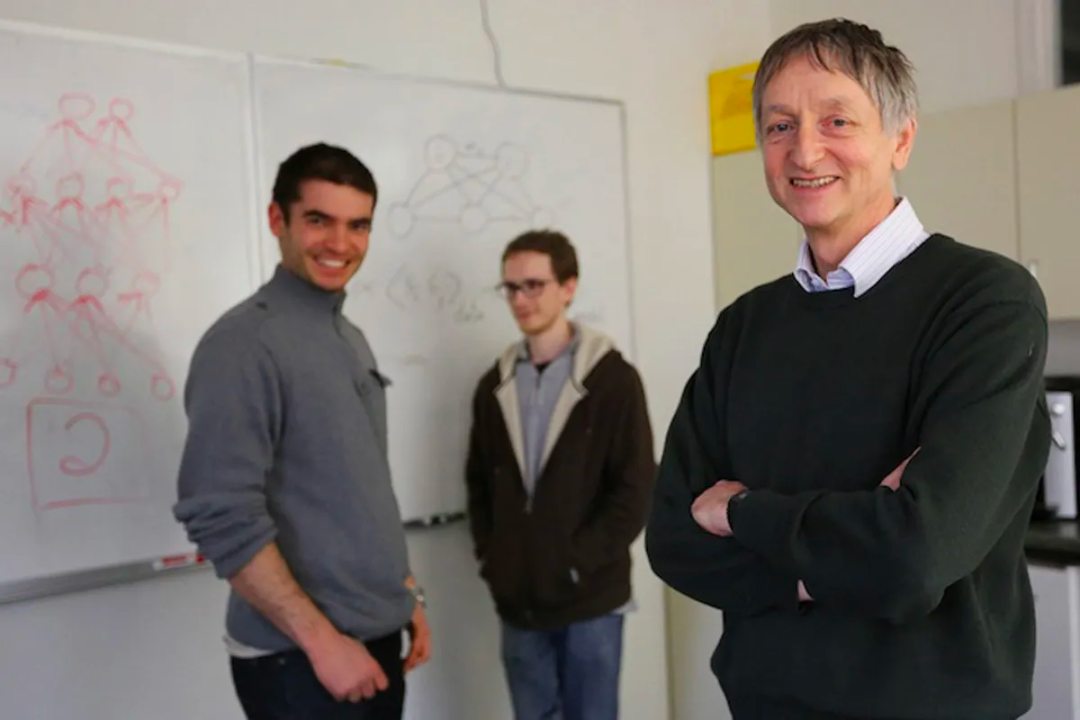
很佩服的一个Google大佬,离职了。。
这两天,科技圈又有一个突发的爆款新闻相信不少同学都已经看到了。 那就是75岁的计算机科学家Geoffrey Hinton从谷歌离职了,从而引起了科技界的广泛关注和讨论。 而Hinton自己也证实了这一消息。 提到Geoffrey Hinton这个名字,对于一些了解过…...
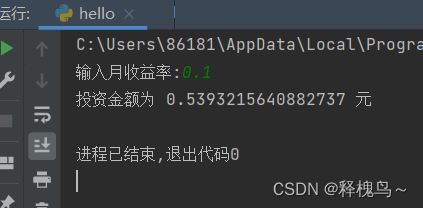
【Python习题集1】Python 语言基础知识
python习题 一、实验内容二、实验总结 一、实验内容 1、运用输入输出函数编写程序,将华氏温度转换成摄氏温度。换算公式:C(F-32)*5/9,其中C为摄氏温度,F为华氏温度。 (1)源代码: ffloat(input(输入华氏温…...

C语言进阶——数据在内存中的存储,你知道吗?
今天我们深度剖析数据在内存中的存储: 重点知识: 1、数据类型详细介绍 2、整形在内存中的存储:原码、反码、补码 3、大小端字节序介绍及判断 4、浮点型在内存中的存储解析 之前我们涉及关于这一部分的知识只是大致的进行讲解࿰…...

规则引擎----easy rules
一、规则引擎的作用 将复杂的if else判断剥离出来 二、使用 2.1、引入POM <!--easy rules核心库--><dependency><groupId>org.jeasy</groupId><artifactId>easy-rules-core</artifactId><version>3.3.0</version></depe…...

你手写过一把锁吗?你对轮询缓存怎么看?
当多个线程同时去操作一块内存的数据时如果不做一些限制,极其可能出现数据一致性问题。这时候,我们用一把锁锁住这块数据,持有钥匙者可以进入,不持有者等待钥匙用完再分配。所以在我看来啊,锁的本质就是一个标志位&…...

深入理解 spring-boot-starter-parent
目录 一、前言二、Maven继承三、分析spring-boot-starter-parent四、Maven单继承问题五、不继承spring-boot-starter-parent需要注意的 一、前言 在idea当中创建springboot项目的时候都会继承一个spring-boot-starter-parent作为父类,假如不继承我们的项目就不能使…...
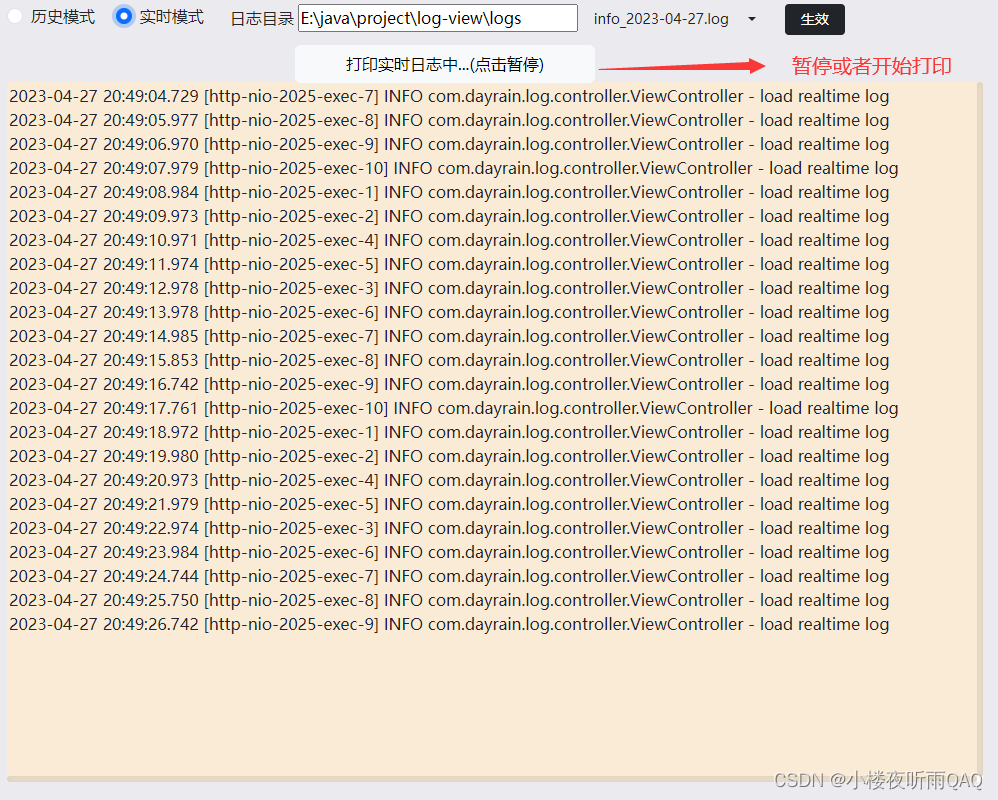
基于SpringBoot的线上日志阅读器
软件特点 部署后能通过浏览器查看线上日志。支持Linux、Windows服务器。采用随机读取的方式,支持大文件的读取。支持实时打印新增的日志(类终端)。支持日志搜索。 使用手册 基本页面 配置路径 配置日志所在的目录,配置后按回车…...

【Leetcode -405.数字转换为十六进制数 - 409.最长回文串】
Leetcode Leetcode -405.数字转换为十六进制数Leetcode - 409.最长回文串 Leetcode -405.数字转换为十六进制数 题目:给定一个整数,编写一个算法将这个数转换为十六进制数。对于负整数,我们通常使用 补码运算 方法。 注意 : 十六进制中所有…...

剑指 Offer:003 前 n 个数字二进制中 1 的个数
题目: 给定一个非负整数 n,请计算 0 到 n 之间的每个数字的二进制表示中 1 的个数,并输出一个数组 示例: 1、 输入: n 2 输出: [0,1,1] 解释: 0 --> 0 1 --> 1 2 --> 10 2、 输入: n 5 输出: [0,1,1,2,1,2] 解释: 0 …...
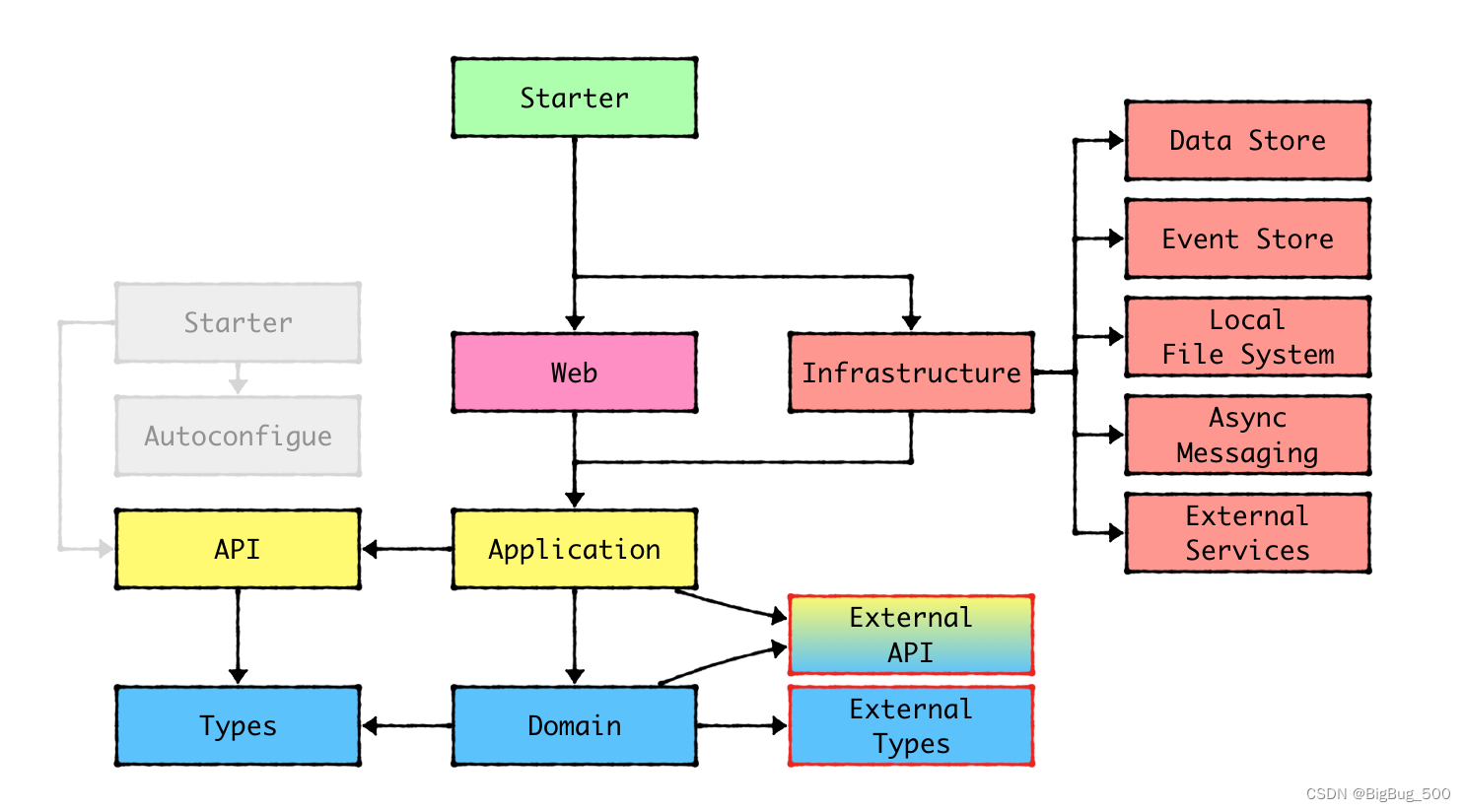
DDD系列:二、应用架构设计演变
作用: 通过规定一个固定的架构设计,可以让团队内有一个统一的开发规范,降低沟通成本,提升效率和代码质量。 目标: 在做架构设计时,一个好的架构应该需要实现以下几个目标: 独立于UI:前…...
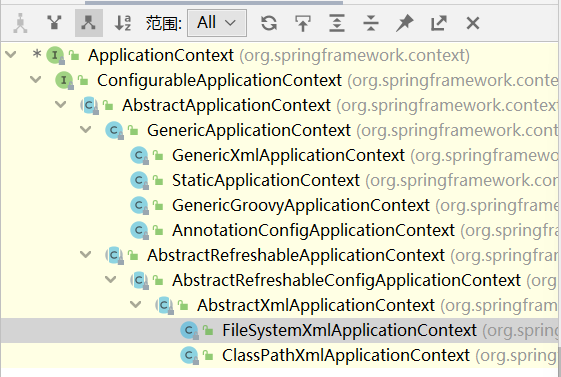
Spring-IOC
IOC概念和原理 什么是IOC 控制反转,为了将系统的耦合度降低,把对象的创建和对象直接的调用过程权限交给Spring进行管理。 IOC底层原理 XML解析 通过Java代码解析XML配置文件或者注解得到对应的类的全路径,获取对应的Class类 Class clazz …...

基于Java语言开发B/S架构实现的云HIS
一、云HIS系统框架简介 1、技术框架 (1)总体框架: SaaS应用,全浏览器访问 前后端分离,多服务协同 服务可拆分,功能易扩展 (2)技术细节: 前端:AngularNg…...

清洁赛道新势力,米博凭“减法”突围?
在五四青年节这个特殊的日子,方太旗下的高端智能清洁品牌“米博”发布了新一代无滚布洗地机7系列。 5月4日晚,米博以“减法生活,净请7代”为主题,举办了新品发布会。在发布会上,从小红书翻红的董洁作为方太集团米博产…...

代码随想录训练营Day6| 242、349、202、1
242. 有效的字母异位词 给定两个字符串 s 和 t ,编写一个函数来判断 t 是否是 s 的字母异位词。 注意:若 s 和 t 中每个字符出现的次数都相同,则称 s 和 t 互为字母异位词。 class Solution {public boolean isAnagram(String s, String t)…...
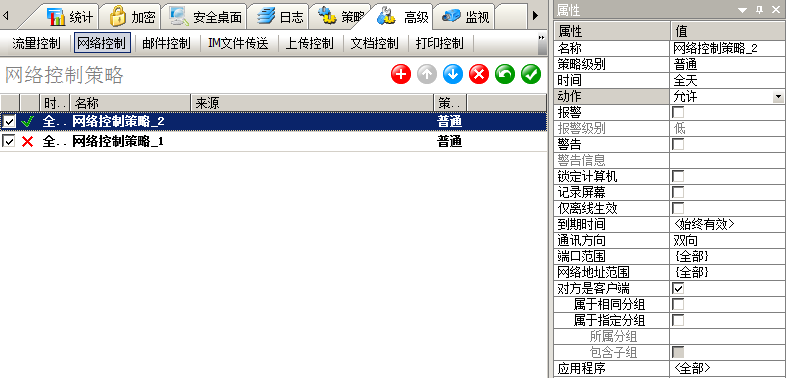
IP-GUARD如何通过网络控制策略禁止应用程序联网?
如何通过网络控制策略禁止应用程序联网? 可以在控制台-高级-网络控制中,添加以下策略: 动作:“禁止” 应用程序:填写要禁止的程序(以QQ示例) 如何禁止没有安装客户端的电脑访问客户端电脑? 可以给所有客户端设置只允许客户端电脑访问的网络控制策略; 在控制台左边的…...

Java RSA密钥转换,从RSAPrivateKey得到RSAPublicKey
概述: 在Java编程中,我们经常用到如下一段代码来生成RSA公私钥,分别拿到公私钥然后加解密计算: KeyPairGenerator keyPairGen; keyPairGen KeyPairGenerator.getInstance("RSA"); keyPairGen.initialize(2048, new S…...

Java如何权衡是使用无序的数组还是有序的数组
在 Java 中,选择有序数组还是无序数组取决于具体场景的性能需求与操作特点。以下是关键权衡因素及决策指南: ⚖️ 核心权衡维度 维度有序数组无序数组查询性能二分查找 O(log n) ✅线性扫描 O(n) ❌插入/删除需移位维护顺序 O(n) ❌直接操作尾部 O(1) ✅内存开销与无序数组相…...

微信小程序云开发平台MySQL的连接方式
注:微信小程序云开发平台指的是腾讯云开发 先给结论:微信小程序云开发平台的MySQL,无法通过获取数据库连接信息的方式进行连接,连接只能通过云开发的SDK连接,具体要参考官方文档: 为什么? 因为…...

深入解析C++中的extern关键字:跨文件共享变量与函数的终极指南
🚀 C extern 关键字深度解析:跨文件编程的终极指南 📅 更新时间:2025年6月5日 🏷️ 标签:C | extern关键字 | 多文件编程 | 链接与声明 | 现代C 文章目录 前言🔥一、extern 是什么?&…...

AI书签管理工具开发全记录(十九):嵌入资源处理
1.前言 📝 在上一篇文章中,我们完成了书签的导入导出功能。本篇文章我们研究如何处理嵌入资源,方便后续将资源打包到一个可执行文件中。 2.embed介绍 🎯 Go 1.16 引入了革命性的 embed 包,彻底改变了静态资源管理的…...

CSS设置元素的宽度根据其内容自动调整
width: fit-content 是 CSS 中的一个属性值,用于设置元素的宽度根据其内容自动调整,确保宽度刚好容纳内容而不会超出。 效果对比 默认情况(width: auto): 块级元素(如 <div>)会占满父容器…...

CRMEB 中 PHP 短信扩展开发:涵盖一号通、阿里云、腾讯云、创蓝
目前已有一号通短信、阿里云短信、腾讯云短信扩展 扩展入口文件 文件目录 crmeb\services\sms\Sms.php 默认驱动类型为:一号通 namespace crmeb\services\sms;use crmeb\basic\BaseManager; use crmeb\services\AccessTokenServeService; use crmeb\services\sms\…...
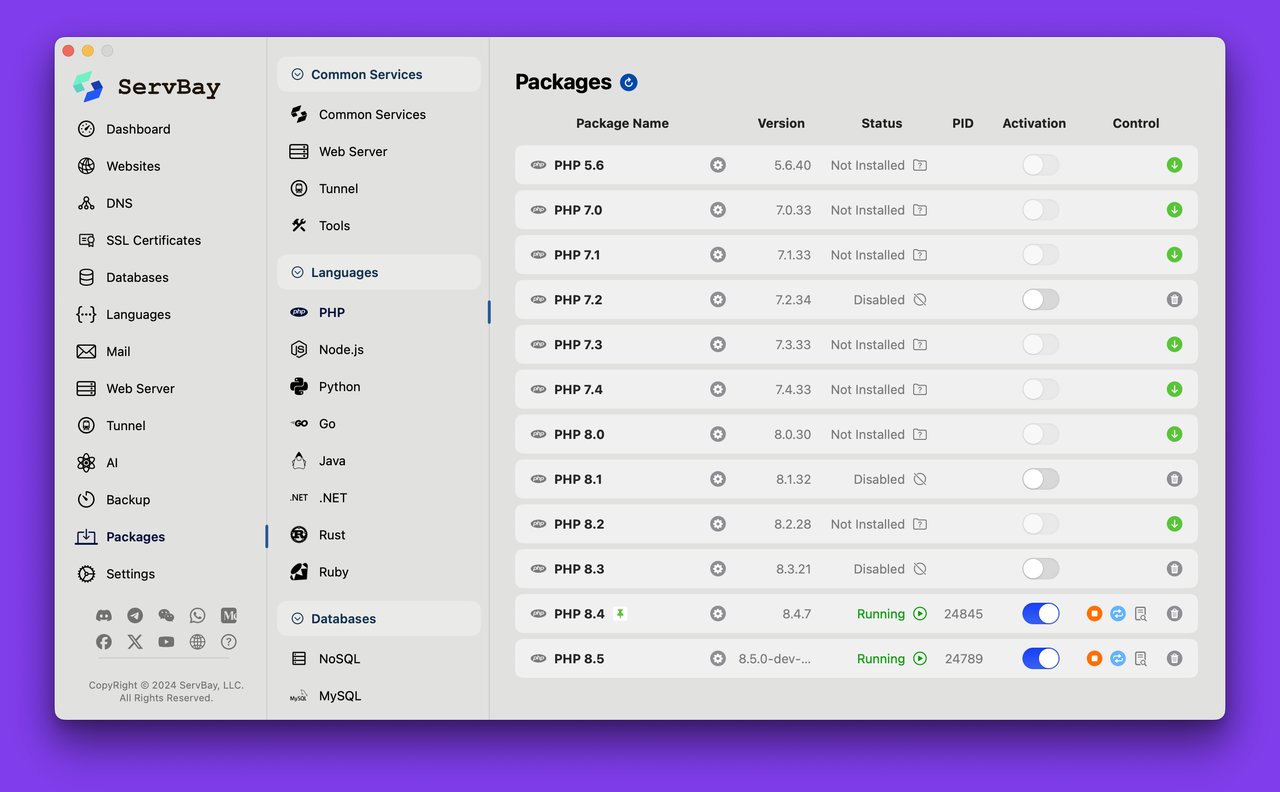
PHP 8.5 即将发布:管道操作符、强力调试
前不久,PHP宣布了即将在 2025 年 11 月 20 日 正式发布的 PHP 8.5!作为 PHP 语言的又一次重要迭代,PHP 8.5 承诺带来一系列旨在提升代码可读性、健壮性以及开发者效率的改进。而更令人兴奋的是,借助强大的本地开发环境 ServBay&am…...

【学习笔记】erase 删除顺序迭代器后迭代器失效的解决方案
目录 使用 erase 返回值继续迭代使用索引进行遍历 我们知道类似 vector 的顺序迭代器被删除后,迭代器会失效,因为顺序迭代器在内存中是连续存储的,元素删除后,后续元素会前移。 但一些场景中,我们又需要在执行删除操作…...

手机平板能效生态设计指令EU 2023/1670标准解读
手机平板能效生态设计指令EU 2023/1670标准解读 以下是针对欧盟《手机和平板电脑生态设计法规》(EU) 2023/1670 的核心解读,综合法规核心要求、最新修正及企业合规要点: 一、法规背景与目标 生效与强制时间 发布于2023年8月31日(OJ公报&…...
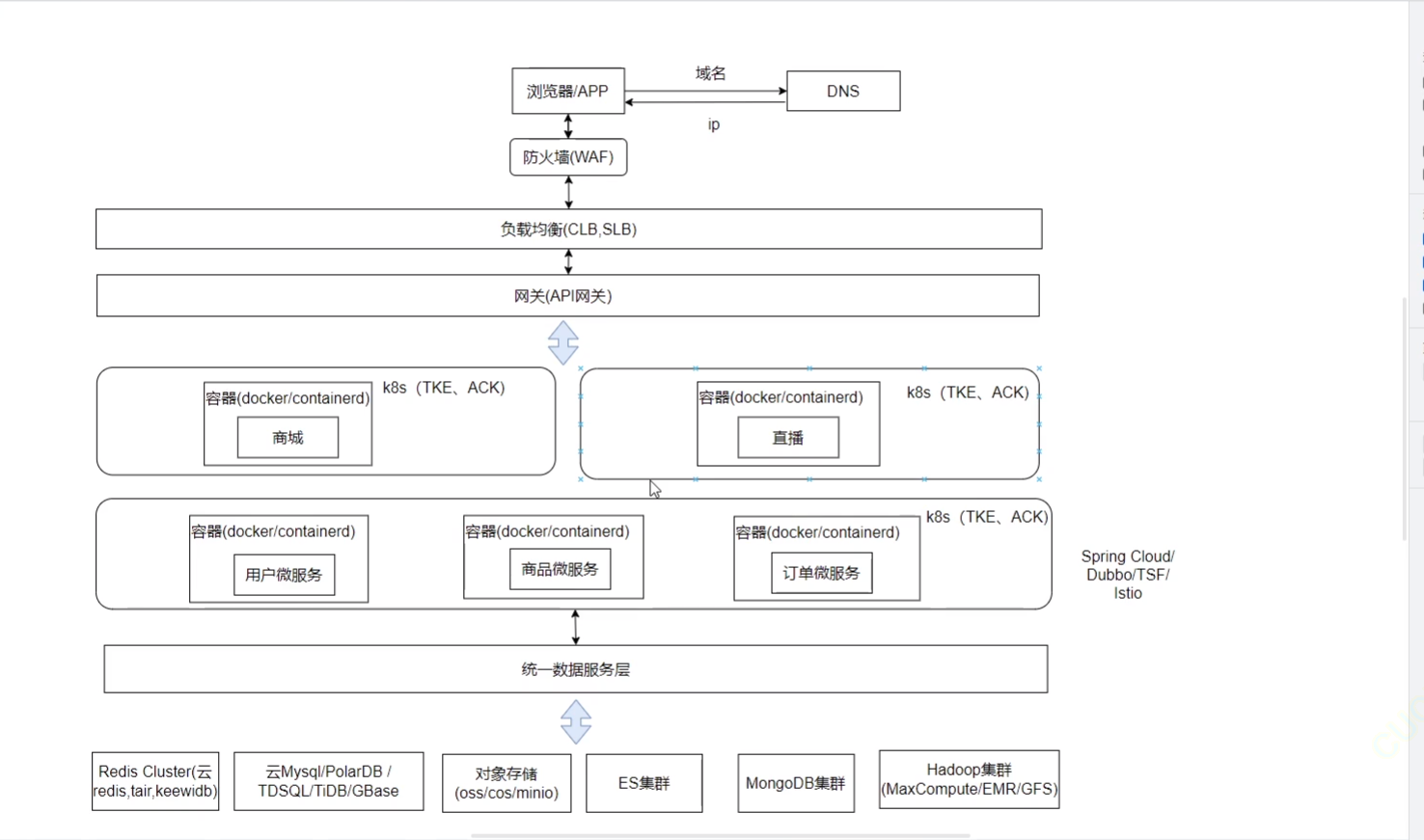
《Docker》架构
文章目录 架构模式单机架构应用数据分离架构应用服务器集群架构读写分离/主从分离架构冷热分离架构垂直分库架构微服务架构容器编排架构什么是容器,docker,镜像,k8s 架构模式 单机架构 单机架构其实就是应用服务器和单机服务器都部署在同一…...
